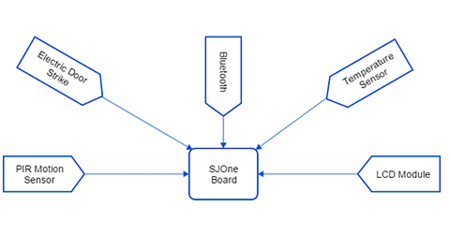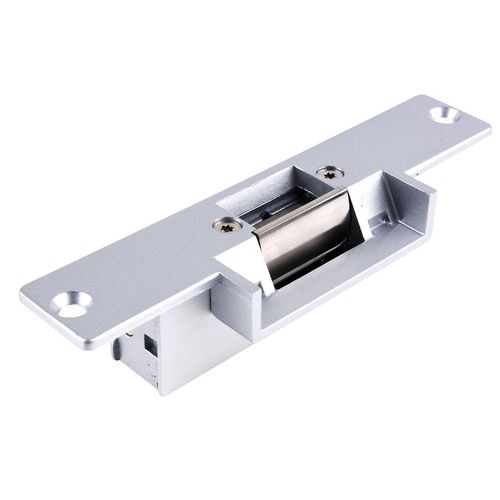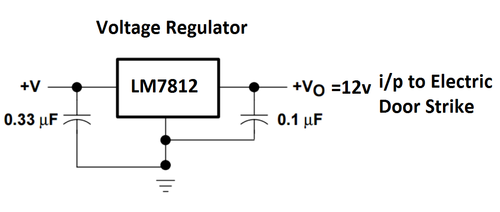Difference between revisions of "S16: SmartDoorLock"
Proj user15 (talk | contribs) (→Electric Door Strike) |
Proj user15 (talk | contribs) (→Electric Door Strike) |
||
| Line 175: | Line 175: | ||
The door strike being used in this project is of the type "fail-secure". This means that when there is no power being supplied to the strike, it remains locked. When a DC power supply of 12V is given, the strike unlocks, which can be detected by the characteristic clicking sound it makes. | The door strike being used in this project is of the type "fail-secure". This means that when there is no power being supplied to the strike, it remains locked. When a DC power supply of 12V is given, the strike unlocks, which can be detected by the characteristic clicking sound it makes. | ||
| − | [[File:CmpE244_S16_SmartDoorLock_Electric_door_srike.jpg| | + | [[File:CmpE244_S16_SmartDoorLock_Electric_door_srike.jpg|500px|thumb|left|text-top|Fig 2. Electric Door Strike]] |
The 3.3V supplied by our SJOne board is not sufficient for operation of the strike, which needs 12V. Hence, we designed a power supply circuit to supply the strike with 12V. The circuit consists of a 12V supply, a 15V to 12V voltage regulator and a couple of capacitors. | The 3.3V supplied by our SJOne board is not sufficient for operation of the strike, which needs 12V. Hence, we designed a power supply circuit to supply the strike with 12V. The circuit consists of a 12V supply, a 15V to 12V voltage regulator and a couple of capacitors. | ||
| − | [[File:CmpE244_S16_SmartDoorLock_VoltageSupply.png| | + | [[File:CmpE244_S16_SmartDoorLock_VoltageSupply.png|500px|thumb|right|Fig 3. 12V Voltage supply to Electric Door strike]] |
// Put circuit diagram, diagram of voltage regulator here | // Put circuit diagram, diagram of voltage regulator here | ||
Revision as of 06:31, 24 May 2016
Contents
- 1 Grading Criteria
- 2 SmartDoorLock
- 3 Abstract
- 4 Objectives & Introduction
- 5 Schedule
- 6 Parts List & Cost
- 7 Design & Implementation
- 8 Electric Door Strike
- 9 Bluetooth Module
- 10 PIR Motion Sensor Module
- 11 LCD Module
- 12 Door lock and unlock
- 13 Automatic door opening by motion sensing
- 14 Temperature display at the entrance
- 15 Testing & Technical Challenges
- 16 Conclusion
- 17 References
Grading Criteria
- How well is Software & Hardware Design described?
- How well can this report be used to reproduce this project?
- Code Quality
- Overall Report Quality:
- Software Block Diagrams
- Hardware Block Diagrams
- Schematic Quality
- Quality of technical challenges and solutions adopted.
SmartDoorLock
Abstract
The frustration when you forget or lose the keys to your door is a common experience. SmartDoorLock provides a mechanism to lock and unlock your door with just your mobile phone, using bluetooth communication. The door also opens automatically when it senses an object approaching from the inside. An additional feature in the project is that a display near the entrance informs you about the weather outside, and gives friendly suggestions accordingly.
Objectives & Introduction
- Communication between Bluetooth Module and Android app
- Locking and unlocking electric strike via Bluetooth with password protection.
- Detecting motion using PIR motion sensor.
- Automatic unlocking the door based on motion detection.
- Reading temperature and displaying suggestions.
Team Members
- Arpita Ramanath
- Sravani Aitha
Responsibilties
- Circuit design for Electric door strike
- Establishing Bluetooth communication between SJone Board and Android app using Uart.
- Building power circuits for PIR motion sensor, LCD and Electric door strike
- Interfacing LCD module with SJone Board using Uart.
- Overall Circuit Integration and Testing.
Schedule
| Week# | Date | Task | Status |
|---|---|---|---|
| 1 | 4/26/2016 |
|
Done |
| 2 | 4/26/2016 |
|
Done |
| 3 | 5/03/2016 |
|
Done |
| 4 | 5/06/2016 |
|
Done |
| 5 | 5/10/2016 |
|
Done |
| 6 | 5/13/2016 |
|
Done |
| 7 | 5/17/2016 |
|
Done |
| 8 | 5/20/2016 |
|
In progress |
Parts List & Cost
| Parts | Cost* |
|---|---|
|
PIR Motion sensor |
$13.87 |
|
Electric Door Strike |
$24.22 |
|
LCD |
$10.99 |
|
BTBee Pro Bluetooth Xbee wireless Module |
$14.99 |
|
SJ-One Board |
$80 x 2 |
Design & Implementation
System Schematic
SmartDoorLock system is designed in a way that the door can be locked and unlocked using an Android app. It also detects motion when someone approaches the door towards the exit. Moreover, an LCD module is fitted near the exit which displays the outside temperature and provides friendly suggestions to the person exiting the door. It has the following components integrated.
- Electric Door Strike: To unlock the door when user sends unlock signal through blurtooth.
- Bluetooth Module: To establish a connection from Android app to SJone Board
- Android app: Application to communicate with the SJone board over Bluetooth.
- PIR Motion sensor: Detects motion if any person is approaching the exit. Based on sensor readings, SJone board sends a signal to electric door strike to unlock the Door.
- Temperature Sensor: SJone board receives outside temperature using temperature sensor and passes it to the LCD to display.
- LCD: To display outside temperature and suggestions to the person exiting the door.
Hardware Design
Electric Door Strike
The door strike being used in this project is of the type "fail-secure". This means that when there is no power being supplied to the strike, it remains locked. When a DC power supply of 12V is given, the strike unlocks, which can be detected by the characteristic clicking sound it makes.
The 3.3V supplied by our SJOne board is not sufficient for operation of the strike, which needs 12V. Hence, we designed a power supply circuit to supply the strike with 12V. The circuit consists of a 12V supply, a 15V to 12V voltage regulator and a couple of capacitors.
// Put circuit diagram, diagram of voltage regulator here
Bluetooth Module
The bluetooth module we are using is the BTBee Pro Xbee Wireless Bluetooth Module from Adafruit. The pins of this module are perfectly compatible with the pins of the SJOne board such that it can be directly fixed on to the board (as shown in the diagram).
// Put image of bluetooth on SJOne board here.
The bluetooth module is interfaced with SJOne using UART2. When a connection is established, it is possible to send and receive messages via bluetooth between the Android App and SJOne board. This section does not require any other hardware.
PIR Motion Sensor Module
The PIR Motion Sensor from Adafruit allows us to sense motion, usually used to detect whether a human has moved in or out of the sensor's range. The sensitivity of this particular sensor is upto 20 feet. It needs a DC power supply of 5V. The circuit we are using to supply 5V to the sensor is similar to the 12V power supply circuit that was designed for the electric door strike. The sensor is interfaced with the SJOne board. The output wire of the sensor is connected to a GPIO pin (made as input) on the SJOne board.
// Put sensor with SJOne board image here
When motion is detected, a logic "1" is sent via the output wire of the sensor to the board. When there is no motion detected, the SJOne board receives a logic "0".
LCD Module
A 20x4 LCD(CM 204-1) module along with a LCD driver by SJValley Engineering is used in the project. The LCD is provided a 5V DC power supply from the same circuit that provides power supply to the motion sensor. The connections between the SJOne board and LCD module are as shown in the diagram below.
// Put LCD and SJOne board connection diagram here.
The LCD module is interfaced with the SJOne board using UART. We have to make sure to set the baud rate correctly before any communication.
System Operation
The basic operation of the system can be divided into 3 parts.
Door lock and unlock
- A connection between the bluetooth module and android app is established using UART2.
- A message "LOCK" or "OPEN" is sent from the app to the bluetooth module.
- If the bluetooth module receives a message "OPEN", it reverts to the app asking for a password.
- Now a password is sent from the app to the bluetooth module.
- The password is verified.
- If the password is a match, the SJOne board closes a switch between the electric door strike and 12V power supply.
- The door is unlocked.
- If the password do not match, an error message is sent to the app.
- If a message "LOCK" is received by the bluetooth module, The SJOne board cuts off power supply to the strike using the switch.
- The door is locked.
//Put strike-flow diagram here
Automatic door opening by motion sensing
- The PIR motion sensor is connected to the SJOne board, which in turn is connected to the strike via a switch.
- When motion is detected on the inside of the door, the sensor send a logic "1" to the SJOne board.
- The SJOne board closes the switch between the electric strike and power supply.
- The door opens.
- When the sensor stops detecting motion, it sends a logic "0" to the board.
- The switch between the strike and power supply is opened.
- The door closes.
//Put sensor-flow diagram here
Temperature display at the entrance
- SJOne board has temperature sensors embedded in it.
- The outside temperature values are sensed, and sent to a LCD module.
- The LCD module is interfaced to the SJOne board using UART.
- The temperature values are displayed, along with appropriate and friendly suggestions to a person leaving the house!!
//Put lcd flow diagram here
Software Design
Show your software design. For example, if you are designing an MP3 Player, show the tasks that you are using, and what they are doing at a high level. Do not show the details of the code. For example, do not show exact code, but you may show psuedocode and fragments of code. Keep in mind that you are showing DESIGN of your software, not the inner workings of it.
Implementation
This section includes implementation, but again, not the details, just the high level. For example, you can list the steps it takes to communicate over a sensor, or the steps needed to write a page of memory onto SPI Flash. You can include sub-sections for each of your component implementation.
Testing & Technical Challenges
Describe the challenges of your project. What advise would you give yourself or someone else if your project can be started from scratch again? Make a smooth transition to testing section and described what it took to test your project.
Include sub-sections that list out a problem and solution, such as:
My Issue #1
Discuss the issue and resolution.
Conclusion
Conclude your project here. You can recap your testing and problems. You should address the "so what" part here to indicate what you ultimately learnt from this project. How has this project increased your knowledge?
Project Video
Upload a video of your project and post the link here.
Project Source Code
References
Acknowledgement
Any acknowledgement that you may wish to provide can be included here.
References Used
List any references used in project.
Appendix
You can list the references you used.


